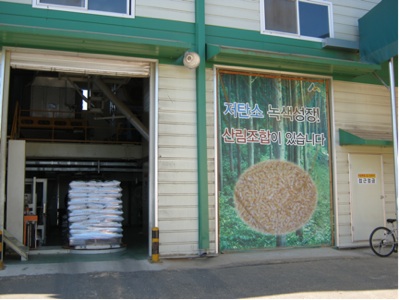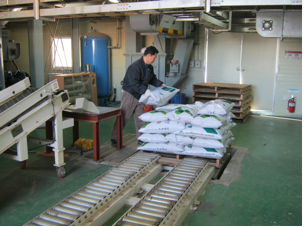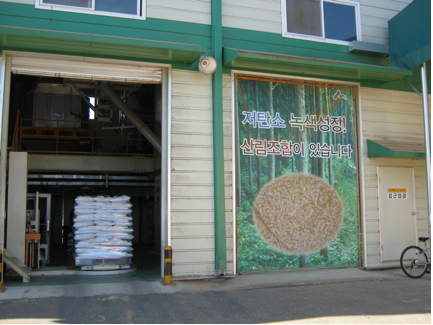
Exploring new pellet markets
January 26, 2011
By Gordon Murray | WPAC
 Jan. 26, 2011 – Korea has a
growing interest in wood pellets and renewable energy.
Jan. 26, 2011 – Korea has a
growing interest in wood pellets and renewable energy.

|
|
| This Korean pellet plant is integrated with other wood processing facilities.
|
Jan. 26, 2011 – Korea has a
growing interest in wood pellets and renewable energy. So much so that Korean
officials invited Gordon Murray, executive director of the Wood Pellet
Association of Canada, to give a presentation on Canadian wood pellets at the
International Biomass Energy Seminar. The seminar was part of the Korea Green
Technology and Industry Exhibition hosted by
Incheon Metropolitan City in late November 2010. While there, Murray also
explored opportunities for Canada to export pellets to Korea. The conference
involved visits to a greenhouse operation heated by pellet boilers, a residence
heated by a pellet boiler and in-floor hot water heat, a sawmill/pellet
operation, and a pellet boiler factory.
Approximately 200 delegates
attended the seminar, representing government, universities, power companies,
and large industrial energy consumers. The Korean television network Daejeon MBC
covered the event for a one-hour program on biomass energy in February 2011.
Seminar presenters included, among others: Kenichiro Kojima of Japan Pellet Club, who talked about
the pellet situation in Japan; Dr. Larry Baxter of Brigham Young University in
Utah, who talked about biomass co-firing in power plants; and Dr. August Raggam
of KWB Boilers, who talked about biomass co-generation.
Key seminar messages
-
South Korea can learn from Europe’s biomass experience. The European Commission
recently implemented an Energy Program for Recovery to accelerate
infrastructure investment, improve energy supply security, and accelerate
implementation of the 20/20/20 objectives for 2020. -
In Europe, biomass provides 69% of renewable energy. As of 2007, biomass provided
98 million tonnes of oil equivalent (Mtoe) compared to 27 Mtoe for hydro, 9
Mtoe for wind, 6 Mtoe for geothermal, and 2 Mtoe for solar. - Wood biomass is predominant, providing over 80% of European biomass energy.
-
South Korea is the world’s 10th largest energy consumer, fifth largest oil importer,
and second largest coal importer. A whopping 64% of electricity of produced
from fossil fuels. - South Korean coal consumption, currently 122 million tons/year, is increasing.
-
South Korea is committed to a 30% reduction in CO2 emissions from
projected levels by 2020. The government has directed 374 of South Korea’s
largest companies (including petrochemical producers, paper and wood
manufacturers, power generators, steel manufacturers, and electronic chip
manufacturers) to reduce CO2 emissions by 2020. Each company must
submit a plan to government by mid-2011 and begin implementation in 2012. -
Renewable portfolio standards for power generators are being implemented in 2012. Power
companies must produce at least 2% renewable energy in 2012, increasing by
0.5%/year to a minimum of 10% by 2020. -
Potential pellet competition for Canada will be from Southeast Asian countries (i.e.,
Vietnam, Cambodia, Laos, Malaysia, and Indonesia), New Zealand, and Australia.
Pellets are considered by Korean companies to be one of the most cost-effective
forms of energy for meeting CO2 reduction targets. It will be
important for Canadian pellet producers to focus on the Korean market in 2011
so as to acquire market share in advance of the 2012 implementation of
renewable portfolio standards. -
Japanese companies have already begun limited co-firing of wood pellets with coal for
power generation. Japan has 51 pellet plants collectively producing about 36,000
tons/year, with a further 60,000 tons/year being imported. Power companies are
becoming somewhat more interested in co-firing with pellets, but so far,
insufficient policy incentives exist to create widespread adoption of the
practice. -
Co-firing biomass with coal is the most affordable, efficient, and environmentally benign
form of renewable power production and there is little technical risk to power
generators.
 |
|
| A worker stacks bagged pellets on pallets.
|
Korean pellet interests
The Korean pellet market took root
in 2007, when 150 domestic boilers were installed throughout the country. In
Korea, domestic heating is provided by means of boilers heating hot water,
which is then circulated through in-floor pipes to create radiant heat. In
2008, the Korea Forest Service began subsidizing the purchase of domestic
pellet boilers by 60% to 70%. About 600 boilers were installed in 2008, 3,000
in 2009, and 4,000 in 2010. About 6,000 boilers are expected to be installed in
2011. In 2010, commercial greenhouse operators began using pellet boilers for
heat. However, pellets are not yet used for power generation or for any other
industrial purpose.
There are about 23 pellet plants
in Korea. All are extremely small scale, mostly associated with woodworking
operations.
 |
|
| A Korean pellet plant.
|
A small group of conference
delegates visited the National Forestry Cooperatives Federation’s Wood Products
Distribution Centre. The Centre, established in 1997, consists of a log yard,
sawmill, value-added mill, dry kilns, a home construction operation, a
landscape architecture operation, and a pellet plant. The pellet plant began
with one pelletizer in 2009, with a second added in 2010. Pellets are made from
sawdust supplied by the adjacent woodworking operation. The plant consists of a
belt dryer, two small flat-type pelletizers, a pellet cooler, and an automatic
bagging line. All pellets are packaged in 20-kg bags. The plant’s annual
production is 18,000 tonnes, all of which is sold in South Korea.
Print this page